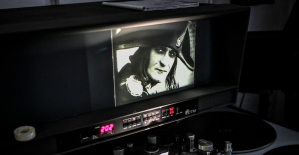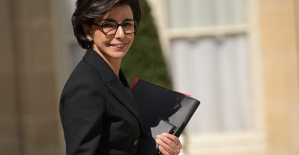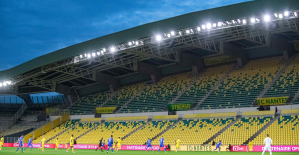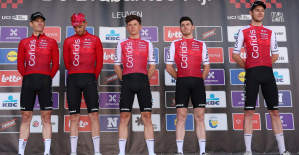The CEO of Ferrari, Benedetto Vigna, assures that the Italian brand will never be a provider of mobility services or make autonomous cars, although it will be a connected, digitized company and will bet on electrification.
Ferrari has presented its strategy for the next four years in which it expects to grow 9% per year in net income to end up at around 6,700 million euros in 2026. In this session with investors, Benedetto Vigna and the rest of the executives of the board of directors made it clear that Ferrari will be carbon neutral by 2030 and reconfirmed that the brand's first electric car "will be unveiled in 2025."
Vigna was also blunt in saying that "don't think of us as a mobility company. We will never be a mobility provider. In a future where more and more cars will be shared, owning a Ferrari will have even more meaning and value than today." in day".
Similarly, Vigna explained that "the Ferraris will have many sensors and the most powerful software processors to improve the driving experience, but they will not be used to create an autonomous Ferrari."
Therefore, in the current trends of automobile companies, Ferrari stands out from the rest and will not become a provider of mobility services or make autonomous cars. It is logical, "because we are a luxury company that provides unique experiences and cars," said Vigna. Now, yes, "we will be a connected, digitized company and we will bet on electrification".
Regarding this last matter, "the first electric Ferrari will be an authentic Ferrari" explained Vigna and "it will have its roots in the experience we have in competition. From it we will use the electric motor with the highest power density and we will apply the aerodynamics of our team to reduce resistance. So the engine will be made in Maranello, the headquarters of Ferrari. "The engine is the soul", said Enzo Ferrari, the founder of the brand, so "the [electric] engine will continue to be the brand, along with other components that we consider critical to differentiate our technology and performance from our competition", According to Viña
Among these components, the battery will also be critical, but "we don't make the aluminum, we use it, we don't make the battery chemistry, we use it," Vigna said. "We are going to design the battery in such a way that it will be integrated into the car in such a way that weight is reduced and performance is not compromised."
Another of the doubts that the first electric Ferrari brought with it is whether it will have sound. "Like any engine, the Ferrari electric motor will have its own sound." Now, he has to wait to hear it. And Vigna made it clear that "it is true that an electric motor can be simple enough to make a washing machine, but if you want to be serious and do something unique, you need a great development".
Beyond the electric car that will arrive in 2025, Vigna and Enrico Galierra, the brand's chief commercial officer, announced that "Ferrarri will launch 15 new models between now and 2026." The first to arrive will be the Purosangue, the first Ferrari SUV to have a naturally aspirated V12 engine "because it has to be a real Ferrari and not just another SUV," Vigna said.
Both executives explained that, contrary to expectations, the Purosangue will not be the model with the highest volume. "We expect deliveries to be below 20%. It's the way we think we'll be able to maintain the value of the brand." Galiera insisted that by the time the car is presented in September "we will be ready to deliver the cars because the order book is very important."
Galiera also explained that "we will soon discover the new supercar" that will be the top of the range of the brand. Regarding the positioning of the Purosangue within the range, it will be between the comfort offered by the Roma and the benefits of the 812 Superfast.
Returning to electrification, Ferrari has four hybrid models in its range today, the 296 GTO and 296 GTS and the SF90 Stradale and SF90 Spider, the first two with a V8 turbo combustion engine and the second two with the V6 Turbo. Thus, last year Ferrari's sales mix was 80% combustion and 20% hybrids. "We are going to have more hybrids based on the V6 turbo engine because it is the hybrid system that our Formula 1 car is based on."
By increasing electrification in the range, Ferrari expects that in 2026 5% of its sales will be from the 100% electric model, 55% will be from hybrid models and the remaining 40% combustion sports. By 2030, 40% of sales will be 100% electric models, 40% hybrids and 20% combustion engines. "We hope to be carbon neutral in 2030," said Vigna, who also stated that "the combustion engine still has a long way to go and we are working on ecological fuels."
Of course, "I do not think that in this decade we will see a Ferrari powered by hydrogen, but who knows if in the next decade it will exist. We as a responsible company must see what happens and work together with universities and other sectors to develop the technology and be prepared to use it if necessary.
Regarding models, the sales mix would be 5% for the Icona and the future supercar, 10% for the special series, and 85% for the volume models. Looking at future net income, Ferrari expects to reach €6.7bn in 2026 from €4.3bn in 2022. The increase will come from car sales at €2bn while revenue from what the brand calls Life will double. Style up to 400 million euros. In this last section, two fashion collections a year will be created and a new Cavallino restaurant will be opened in Maranello.
In this way, the company expects to go from 1,100 million Ebit and an operating margin of 25% in 2021 to 1,800 or 2,000 million in 2026, increasing profitability to 27-30%. The EBITDA stood at 1,500 million and a 35.9% profitability, figures that they expect to exceed in 2026 to 2,500-2,700 million and a 38-40% margin. The Capex will be 15% of annual revenue in each year from 2023 to 2026. Finally, Ferrari plans to double the accumulated cash flow in this period to 4,600-4,900 million euros.
And shareholders are in luck because the company's intention is to raise the percentage of adjusted income allocated to dividends from 30% to 35%, going from 1,000 million to 2,000 million in the 2023-2026 period. In addition, the 'buyback' will grow from 1,100 million to 2,000 million between June 2022 and 2026.

 Iran-Israel conflict: what we know about the events of the night after the explosions in Isfahan
Iran-Israel conflict: what we know about the events of the night after the explosions in Isfahan Sydney: Assyrian bishop stabbed, conservative TikToker outspoken on Islam
Sydney: Assyrian bishop stabbed, conservative TikToker outspoken on Islam Torrential rains in Dubai: “The event is so intense that we cannot find analogues in our databases”
Torrential rains in Dubai: “The event is so intense that we cannot find analogues in our databases” Rishi Sunak wants a tobacco-free UK
Rishi Sunak wants a tobacco-free UK Alert on the return of whooping cough, a dangerous respiratory infection for babies
Alert on the return of whooping cough, a dangerous respiratory infection for babies Can relaxation, sophrology and meditation help with insomnia?
Can relaxation, sophrology and meditation help with insomnia? WHO concerned about spread of H5N1 avian flu to new species, including humans
WHO concerned about spread of H5N1 avian flu to new species, including humans New generation mosquito nets prove much more effective against malaria
New generation mosquito nets prove much more effective against malaria The A13 motorway closed in both directions for an “indefinite period” between Paris and Normandy
The A13 motorway closed in both directions for an “indefinite period” between Paris and Normandy The commitment to reduce taxes of 2 billion euros for households “will be kept”, assures Gabriel Attal
The commitment to reduce taxes of 2 billion euros for households “will be kept”, assures Gabriel Attal Unemployment insurance: Gabriel Attal leans more towards a tightening of affiliation conditions
Unemployment insurance: Gabriel Attal leans more towards a tightening of affiliation conditions “Shrinkflation”: soon posters on shelves to alert consumers
“Shrinkflation”: soon posters on shelves to alert consumers The restored first part of Abel Gance's Napoléon presented at Cannes Classics
The restored first part of Abel Gance's Napoléon presented at Cannes Classics Sting and Deep Purple once again on the bill at the next Montreux Jazz Festival
Sting and Deep Purple once again on the bill at the next Montreux Jazz Festival Rachida Dati: one hundred days of Culture on the credo of anti-elitism
Rachida Dati: one hundred days of Culture on the credo of anti-elitism The unbearable wait for Marlène Schiappa’s next masterpiece
The unbearable wait for Marlène Schiappa’s next masterpiece Skoda Kodiaq 2024: a 'beast' plug-in hybrid SUV
Skoda Kodiaq 2024: a 'beast' plug-in hybrid SUV Tesla launches a new Model Y with 600 km of autonomy at a "more accessible price"
Tesla launches a new Model Y with 600 km of autonomy at a "more accessible price" The 10 best-selling cars in March 2024 in Spain: sales fall due to Easter
The 10 best-selling cars in March 2024 in Spain: sales fall due to Easter A private jet company buys more than 100 flying cars
A private jet company buys more than 100 flying cars This is how housing prices have changed in Spain in the last decade
This is how housing prices have changed in Spain in the last decade The home mortgage firm drops 10% in January and interest soars to 3.46%
The home mortgage firm drops 10% in January and interest soars to 3.46% The jewel of the Rocío de Nagüeles urbanization: a dream villa in Marbella
The jewel of the Rocío de Nagüeles urbanization: a dream villa in Marbella Rental prices grow by 7.3% in February: where does it go up and where does it go down?
Rental prices grow by 7.3% in February: where does it go up and where does it go down? With the promise of a “real burst of authority”, Gabriel Attal provokes the ire of the opposition
With the promise of a “real burst of authority”, Gabriel Attal provokes the ire of the opposition Europeans: the schedule of debates to follow between now and June 9
Europeans: the schedule of debates to follow between now and June 9 Europeans: “In France, there is a left and there is a right,” assures Bellamy
Europeans: “In France, there is a left and there is a right,” assures Bellamy During the night of the economy, the right points out the budgetary flaws of the macronie
During the night of the economy, the right points out the budgetary flaws of the macronie These French cities that will boycott the World Cup in Qatar
These French cities that will boycott the World Cup in Qatar Champions League: France out of the race for 5th qualifying place
Champions League: France out of the race for 5th qualifying place Ligue 1: at what time and on which channel to watch Nantes-Rennes?
Ligue 1: at what time and on which channel to watch Nantes-Rennes? Marseille-Benfica: 2.99 million viewers watching OM’s victory on M6
Marseille-Benfica: 2.99 million viewers watching OM’s victory on M6 Cycling: Cofidis continues its professional adventure until 2028
Cycling: Cofidis continues its professional adventure until 2028


















